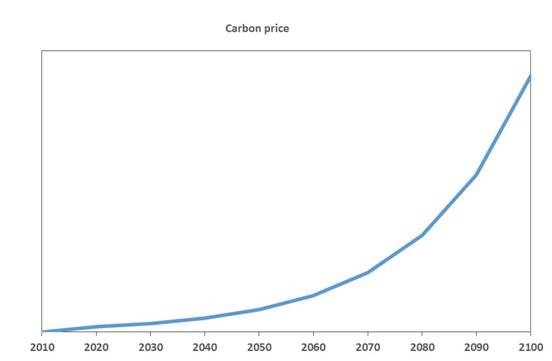Take a look at the chart below, which was taken from a presentation made by Jim Skea, Co-Chair of the Intergovernmental Panel on Climate Change’s (IPCC) Working Group III, to the Parties to UN Framework Convention on Climate Change (UNFCCC) here in Bonn, Germany last week.
The curved line depicts what Mr. Skea describes as the increase in the “level of effort, as measured by carbon price” needed to limit the increase in the average global surface to no more than 2.0°C, the aspirational goal in the Paris Agreement. That’s some steep curve!

But do you notice anything else interesting? That’s right. There’s no vertical axis showing what the carbon price, which is what the chart is supposed to be depicting, actually is.
What’s even more interesting is that this was an error of commission, not omission.
Here’s the deal:
At the Paris climate meeting last December, the Parties to the UNFCCC agreed that it would be useful for the IPCC to provide it with some assessments for it’s planned stock-taking exercises on implementation of the Paris Agreement. The chart reproduced nearby was presented during the “SBSTA-IPCC special event on advice on how the assessments of the IPCC can inform the global stock-take.”
Part of the presentation took a look at an example of a global greenhouse gas emissions trajectory that could potentially achieve the aim of the Paris Agreement. It shows global emissions dipping steeply after 2030, eventually reaching net “0” emissions by 2070 and net negative emissions after that. That’s where this chart comes in.
Mr. Skea told the assembled Parties that the carbon price needed to make such a scenario a reality would need to rise “exponentially” after 2030 and would have to reach “hundreds of dollars per ton.” Yikes!
He also explained that he intentionally left blank the chart’s Y-axis with the estimated carbon prices to “preserve the health” of the Parties. And not one country represented in the room asked him for the figures. Some things really are better left unsaid.
We’ve argued repeatedly that an air of unreality hangs over the international climate change talks. This little episode in Bonn makes the point better than we ever could.

